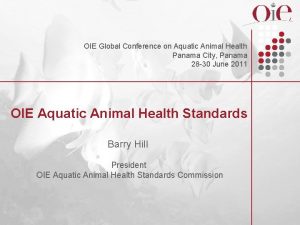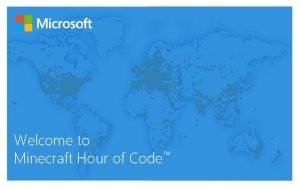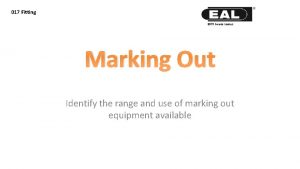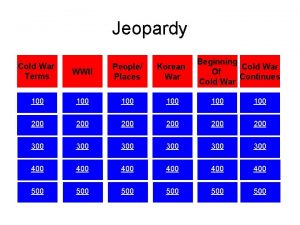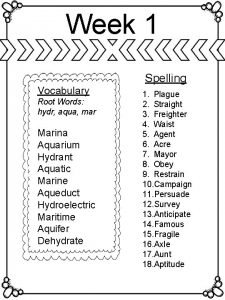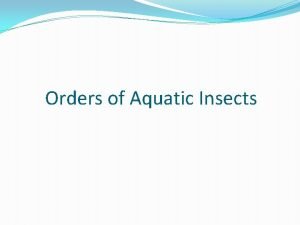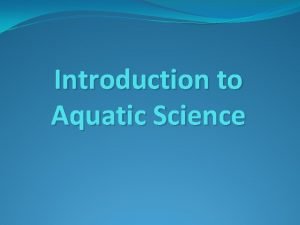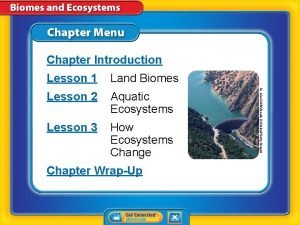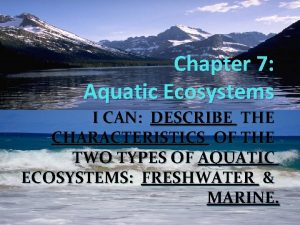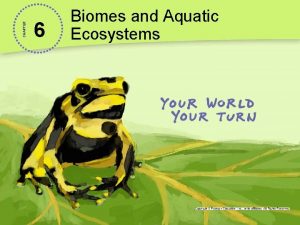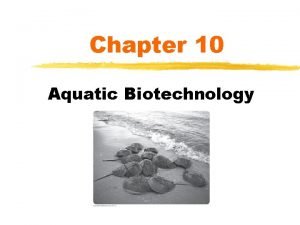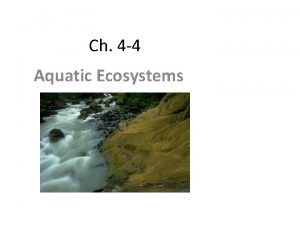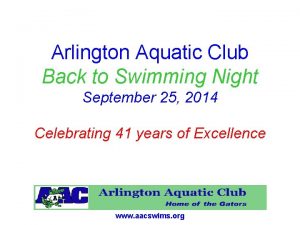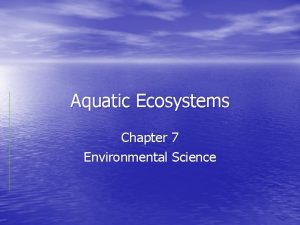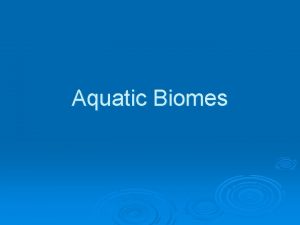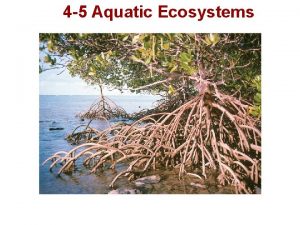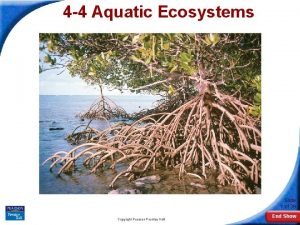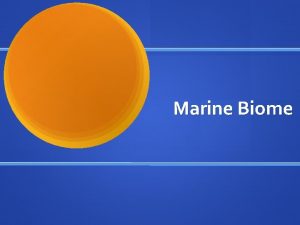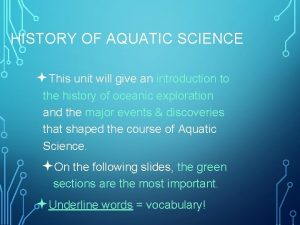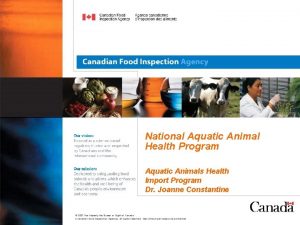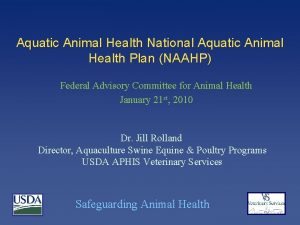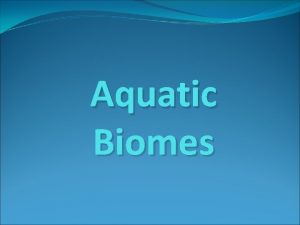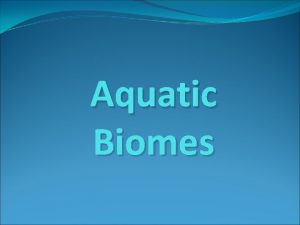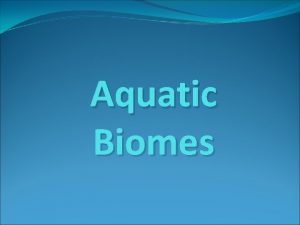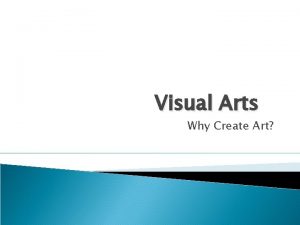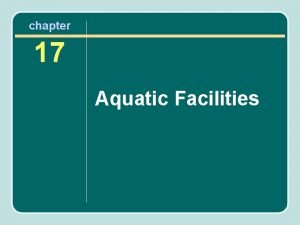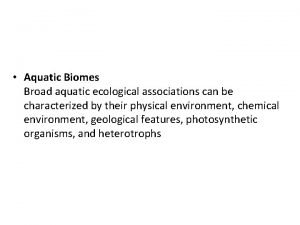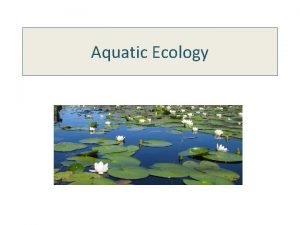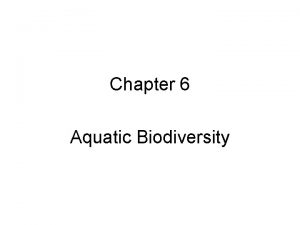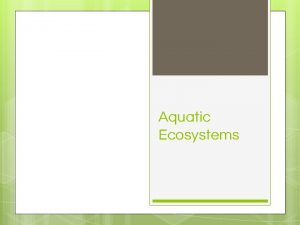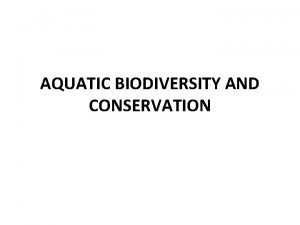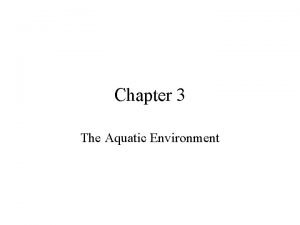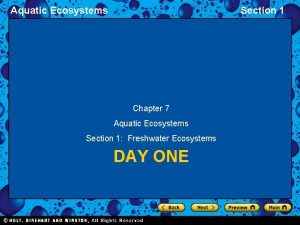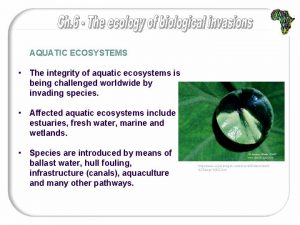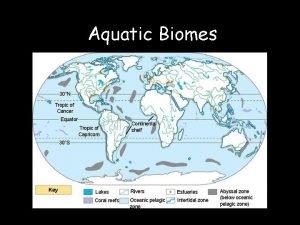Why Create a National Model Aquatic Health Code














































- Slides: 46

Why Create a National Model Aquatic Health Code? LCDR Jasen Kunz, MPH, REHS Centers for Disease Control and Prevention Environmental Health Services Branch New York State Conference of Environmental Health Directors 3 -23 -2011 National Center for Environmental Health Division of Emergency and Environmental Health Services

Factors Contributing to Spread of Pathogens in Treated Swimming Venues · Waterborne pathogens commonly cause infection and can cause diarrhea · Diarrheal illness is common · Exposure to recreational water is common · Swimming is communal bathing · Fecal contamination of recreational water is common · Swallowing recreational water is common · Inadequate pool operation and maintenance not uncommon

Diarrheal Illness is Common • 5% of general public had diarrhea in past month 1 • 0. 6 episodes of diarrhea/person/year • 0. 1– 3. 5 cases of diarrhea/person/year (higher for young children)2 1. Jones TF et al. 2007. Epidemiol Infect 135(2): 293– 301. 2. Roy SL et al. 2006. J Water Health 4(Suppl 2): 31– 69. 1

Percentage Previously Infected with Cryptosporidium in the United States, by age group 1 1. Frost FJ et al. 2004. Ann Epidemiol 14(7): 473– 8.

Exposure to Recreational Water is Common: Americans Swim…a Lot · Swimming is the 3 rd most popular exercise activity in the United States 1 · ~314 million swimming visits each year 1 · Underestimate · >7 years of age · Swim >6 times in last year 1. US Bureau of the Census. 2010 Statistical Abstract of the United States. Recreation and Leisure Activities: Participation in Selected Sports Activities 2007. Available at http: //www. census. gov/compendia/statab/2010/tables/10 s 1212. pdf

Swimming is Communal Bathing · Swimming = Sharing the water and contaminants in it · Actions of pool operator and swimmers affect others

Fecal Contamination of Recreational Water is Common · Heavy use by diapered and toddler-aged children · >Fecal incidents common • 293 formed stools in 47 pools, etc. 2 · ~0. 14 g of feces on peri-anal surface/person · Range: 0. 01 g (adults)– 10 g (children)3 1. Nelson R et al. 1995. JAMA 274(7): 559– 61. 2. CDC. 2001. MMWR 50(20): 410– 2. 3. Gerba CP. 2000. Quant Microbiol 2(1): 55– 68

Swallowing Recreational Water is Common: Water Swallowed While Swimming, by Age Group 1 Group Average Amount of Water Swallowed (m. L)* Range (m. L) Adults 16 (~ ¼ yogurt) 0– 53 37 (~ 1 cup yogurt) 0– 154 Non-adults * Swimmers stayed in pool and actively swam for >45 minutes. 1. Dufour AP et al. 2006. J Water Hlth 4(4): 425– 30.

Inadequate Pool Operation and Maintenance is NOT Uncommon · Pool inspection data from 4 state and 11 local pool inspection programs · Conducted January 1–December 31, 2008 · Inspected >120, 000 pools 1 · 12. 1% of inspections resulted in immediate closure pending correction of violation 1. CDC. 2010. MMWR 59(19): 582– 7.

Outbreaks: What’s in the Water? San Alfonso del Mar in Chile Length: 3, 323 ft long Depth: 115 ft (deep end) Volume: 66 million gallons

Recreational Water Use is Associated with a Spectrum of Illness in Treated Aquatic Venues · Acute gastroenteritis · Cryptosporidium, toxigenic E. coli, Giardia, Shigella, norovirus, chemicals · Dermal infections · Pseudomonas dermatitis/folliculitis, fungal infections · Ear infections (e. g. , Pseudomonas) · Eye infections and irritation · Adenoviruses, chloramines · Respiratory infections and irritation · Legionella, Mycobacterium, chloramines, chemicals · Neurologic infections (e. g. , Echovirus) · Hepatitis (HAV) · Urinary tract infections (e. g. , Pseudomonas)

Recreational Water-Associated Outbreaks by Predominant Illness and Route of Entry: Treated Venues, U. S. , 1995– 2004 Route of Entry (n=159) Ingestion 50. 9% Bather contaminants Inhalation 11. 3% Contact 37. 7% Environmental contaminants & biofilms

Recreational Water Illness Outbreaks, United States, 1978– 2008* * N=685, includes preliminary 2007 and 2008 data (as of 10/14/2009), Yoder JS et al. 2008. MMWR 57(SS-9): 1– 38.

Recreational Water Illness Outbreaks, United States, 1978– 2008* Dermatitis * N=229, includes preliminary 2007 and 2008 data (as of 10/14/2009), Yoder JS et al. 2008. MMWR 57(SS-9): 1– 38.

Recreational Water Illness Outbreaks, United States, 1978– 2008* Gastroenteritis * N=335, includes preliminary 2007 and 2008 data (as of 10/14/2009), Yoder JS et al. 2008. MMWR 57(SS-9): 1– 38.

How Might We Prevent Disease? Why Doesn’t the Government Protect Me?

Current Pool Code Situation · Jurisdiction · Enacted at state/local level · Variability · Significant variation across USA · Uniformity · Lack of uniform national standards covering all design, construction, operation and maintenance needs for all treated recreational venues · Responsiveness: · Difficult to update; many codes out of date and don’t reflect evolving science

Impetus for MAHC · CDC sponsored workshop · “Recreational Water Illness Prevention at Disinfected Swimming Venues” · February 15 -17, 2005 in Atlanta, Georgia · Recommended a need for: · Data-driven, knowledge-based, risk reduction, public health effort to prevent disease and injuries · National model code that would allow health jurisdictions to pull needed information for creating local codes · Regular updating of model code based on new data · Open access to information in model code

Funding and Process · NSPF Board Grant · Spark plug funding · Arch Chemical · Travel funding · CDC · MAHC effort started in 2007 · Volunteer effort

MAHC Vision and Objective · A MAHC that is user-friendly, knowledgebased, and scientifically supported in an effort to reduce risk and promote healthy recreational water experiences. · The MAHC will transform varied swimming pool regulations used by health departments into a uniform set of state and local codes that ensure the health and safety of the swimming public.

MAHC Scope · All areas of public health concern · Public venues · Water, air, facility exposures that impact bathers · Contact, ingestion, immersion, inhalation · Infectious, chemical, safety · Leave other areas to building codes, etc. · Venue types · Man-made water venues · Health care-based pools · Therapy pools

MAHC Process · Transparent · Process, work all posted on website for open access · Inclusive · Will include public health, aquatics sector, and public · Communicative · Will get message out to participate · Timely · Put information out quickly when completed and grade depending on level of data support · Use modular format

MAHC Plan · Data or best practices driven · Avoid prescription when possible · Modular · Easier to complete if modules are updated rather than entire code · Current and updated · Will be modeled after the Conference for Food Protection where a clear process is put in place to revise on a biennial basis based on new data · Free and accessible for all · Web accessible

MAHC Outcomes · Reductions in RWIs · Adoption of minimum standards throughout the U. S. (as with national food safety and building model codes) · Need for mandatory training and education · Improved surveillance systems · Improved data collection · Data-based decision making · Systems-based approaches to facility design, maintenance, and operation · Research agenda

MAHC Process Steering Committee (Director, 9 members) Coordinator & Assistant to Director Technical Committee Public Comment Technical Committee Biennial Conference New or Revised MAHC Module

MAHC Directorate · Director · Douglas Sackett, NYS Dept. of Health · MAHC Coordinator · Lee Tate, CDC · Assistant to the MAHC Director · Amanda Long, NYS Dept. of Health

MAHC Steering Committee · Guides MAHC process; sets priorities; creates TC’s and picks chairs; advises on process/objectives · Exercises editorial control of TC products · Ensures uniformity and fit with mission/objectives · · · · Chip Cleary, Palace Entertainment Water Park Group Tracynda Davis, representing NEHA Jim Dunn, Aquatic Development Group John Linn, Busch Entertainment Corp. Colleen Maitoza, County of Sacramento Charles Neuman, Water Technology Inc. Bob Vincent, Florida Department of Health Charles Otto, Michael Beach, CDC

MAHC Technical Committees · Formulate and creates new code modules · Examine existing technologies and methodologies · Determine scientific basis for recommendations and criteria · Identify scientific information gaps · Outline data needed for future revisions

MAHC Technical Committees · Contamination Burden · Chair: Ellen Meyer, Arch Chemicals · Design and Construction · Chair: Carl Nylander, Councilman & Hunsaker · Facility Maintenance and Operation · Chair: Michael Beatty, Disney · Hygiene · Chair: Ralph Cordell, CDC · Lifeguarding/Bather Supervision · Chair: Kathryn Scott, UC Berkeley · Monitoring and Testing · Chair: Sung Choe, NSF International

MAHC Technical Committees · Operator Training · Chair: Dennis Berkshire, Aquatic Design Group · Recirculation Systems and Filtration · Chair: James Amburgey, University NC · Regulatory Program Admin · Chair: Frank Guido, Westchester Cty Dept Health · Risk Management/Safety · Chair: Amy Duck, Disney World · Ventilation And Air Quality · Chair: Franceen Gonzales, Great Wolf Resorts · Water Quality · Chair: Jim Dingman, Underwriters Lab

MAHC Layout · Code section · Easily read · Organized by number and cross-referenced across sections · Design and construction · Operation and maintenance · Policies and management · Appendices · Supporting information for code · Guidance for disease and injury prevention · Start with “Best Practices” and upgrade as needed

Design and Construction · · · · Materials Structural stability Safety requirements Lighting Electrical Ventilation (indoor air quality, humidity) Water supply Wastewater disposal Circulation systems Filtration Disinfection/p. H Hygiene facilities Water temperature control Construction (new, alterations, replacements)

Operation and Maintenance · · · Water quality parameters Safety parameters Recirculation parameters Indoor air quality parameters Peripheral items (e. g. , slides) Hygiene facilities Monitoring and testing Facility maintenance Potable water and sewage systems Re-opening procedures (after closure) Preventive maintenance plan

Policies and Management · · · · · Lifeguard training Operator training Staffing/Employee illness plan Fecal incident/body fluid policies Swimmer empowerment methods Bather load policies Chemical handling Signage Pool shock Emergency response plan

Process and Status · Post modules for 60 day public comment · · CDC Healthy Swimming website Address public comments Post final version Revise thru “Conference for Swimmer Protection” · 12 modules in various degrees of SC review · Edit for uniformity · MAHC Editor hired by NCEH · First module posted in July 2010 for 60 day comment · All modules up for initial posting in 2011 · Final 1 st edition posted in 2011

MAHC Changes/Requirements · Operator training required · Training course elements defined · Secondary disinfection (e. g. , UV, ozone) required on “high risk” pools · Chemical controllers required · Chemical storage room guidelines · Air ventilation requirements improved · Regulatory program guidance, best practices · Annex explaining rationale

MAHC Launch and Evaluation · Launch package to alert users · Public Health Law package to facilitate usage/adoption · Evaluative tools for tracking implementation · Process indicators (i. e. , wording elements in new codes) · Pool inspection data · Key elements adopted (e. g. , operator training required) · Outcomes improved (i. e. , decrease in critical violations due to all operators being trained) · Health Outcomes · Reduced case reporting and outbreaks, particularly of cryptosporidiosis

Planning for the Future · 1 st edition of MAHC is published · Transition to a permanent structure/organization responsible for maintenance and updating · Strategic planning for future transition and replacement of SC and TC structure · Structure/organization to be developed: · Formal process with regular meetings (e. g. biennial) for hearing issues and proposed changes and to clarify/update the MAHC. · “Executive Board” made up of health officials, industry, academia, and pool users. · May be similar to the Conference for Food Protection (CFP).

More Information: Healthy Water Website http: //www. cdc. gov/healthywater/swimming/pools/mahc/

Environmental Public Health Online Course (EPHOC) · Environmental Public Health Online Courses (EPHOC) http: //www. cdc. gov/nceh/ehs/Workforce_Development/EPHOC. htm · Provide access to comprehensive, worthwhile and affordable workforce development resources for practitioners in environmental public health. · This has been a major issue across the United States for the past decade.

Environmental Public Health Online Course (EPHOC) · EPHOC Target Audience · New-hire environmental public health major with a science major · Individuals preparing for state or national credential exam · Environmental health and other students · Environmental public health professionals wanting to improve their public health knowledge

Environmental Public Health Online Course (EPHOC) · EPHOC Courses · General Environmental Health · Statutes and Regulations · Food Protection · Potable Water · Wastewater · Solid and Hazardous Waste · Hazardous Materials · Disaster Sanitation · Zoonoses, Vectors, Pests and Weeds · Radiation Protection · Occupational Safety and Health · Air Quality and Environmental Noise · Housing Sanitation and Safety · Institutions and Licensed Establishments



Newly Required Disclaimer From the Department of Health and Human Services (Please Interpret as You See Fit) · "The findings and conclusions in this presentation have not been formally disseminated by CDC and should not be construed to represent any agency determination or policy“

Questions? National Center for Environmental Health Division of Emergency and Environmental Health Services
 Model aquatic health code
Model aquatic health code Oie aquatic animal health code
Oie aquatic animal health code Pictures
Pictures National aquatic resources research and development agency
National aquatic resources research and development agency Code.org minecraft aquatic
Code.org minecraft aquatic Jika noel(create(q)) adalah 0, maka front(create(q)) adalah
Jika noel(create(q)) adalah 0, maka front(create(q)) adalah Code commit code build code deploy
Code commit code build code deploy National program related to child health and welfare
National program related to child health and welfare Dont ask
Dont ask Create qr code appspot
Create qr code appspot Why do people create structure and change governments
Why do people create structure and change governments Engineers marking out table
Engineers marking out table Who is narrating the short story charles
Who is narrating the short story charles Why did the framers create a bicameral legislature
Why did the framers create a bicameral legislature Why did stalin want to create a “buffer zone”?
Why did stalin want to create a “buffer zone”? Why can banks create money
Why can banks create money 1 to 25 spelling
1 to 25 spelling Lesson outline lesson 2 aquatic ecosystems answer key
Lesson outline lesson 2 aquatic ecosystems answer key Structure and function of ecosystem
Structure and function of ecosystem Section 3 aquatic ecosystems worksheet answers
Section 3 aquatic ecosystems worksheet answers Are otters semi aquatic
Are otters semi aquatic Conspicuous
Conspicuous Energy flow
Energy flow What is aquatic science?
What is aquatic science? Biomass pyramid of aquatic ecosystem
Biomass pyramid of aquatic ecosystem Tropical rainforest energy pyramid
Tropical rainforest energy pyramid Connecting the concepts aquatic biomes
Connecting the concepts aquatic biomes What are the two main types of aquatic ecosystems
What are the two main types of aquatic ecosystems Chaparral biomes are generally _______.
Chaparral biomes are generally _______. 3 aquatic biomes
3 aquatic biomes Chapter 3 lesson 3 biomes and aquatic ecosystems
Chapter 3 lesson 3 biomes and aquatic ecosystems Aquatic biotechnology
Aquatic biotechnology Section 4-4 aquatic ecosystems
Section 4-4 aquatic ecosystems Bioma air laut
Bioma air laut Evan stiles swimming
Evan stiles swimming Differences between aquatic and terrestrial ecosystems
Differences between aquatic and terrestrial ecosystems What factors describe aquatic ecosystems
What factors describe aquatic ecosystems Limestone ridges built by tiny animals
Limestone ridges built by tiny animals Ap environmental science aquatic biomes
Ap environmental science aquatic biomes Examples of aquatic biomes
Examples of aquatic biomes 4-4 aquatic ecosystems
4-4 aquatic ecosystems Section 4-4 aquatic ecosystems
Section 4-4 aquatic ecosystems Terrestrial food production
Terrestrial food production Morphological adaptations in aquatic plants
Morphological adaptations in aquatic plants Chapter 7 aquatic ecosystems test answers
Chapter 7 aquatic ecosystems test answers Aquatic biomes examples
Aquatic biomes examples History of aquatic science
History of aquatic science

